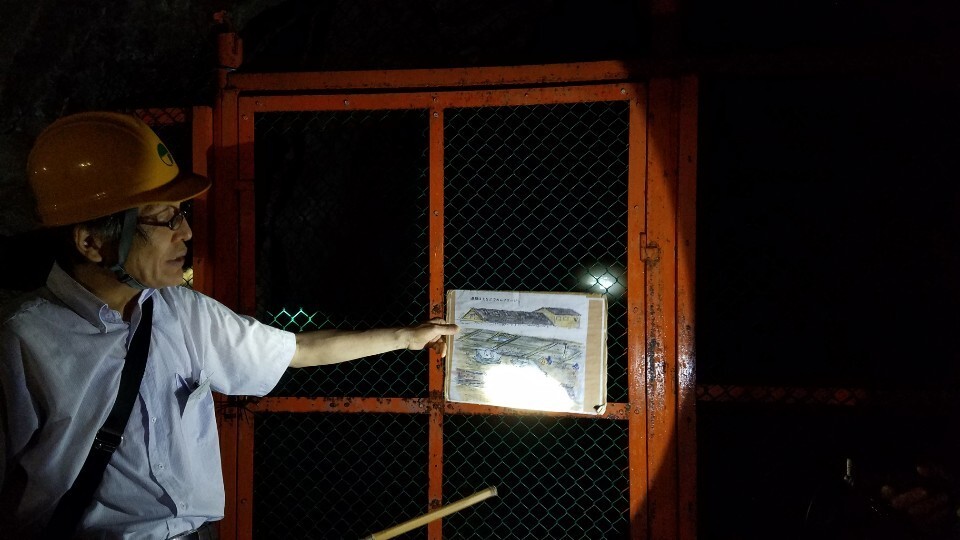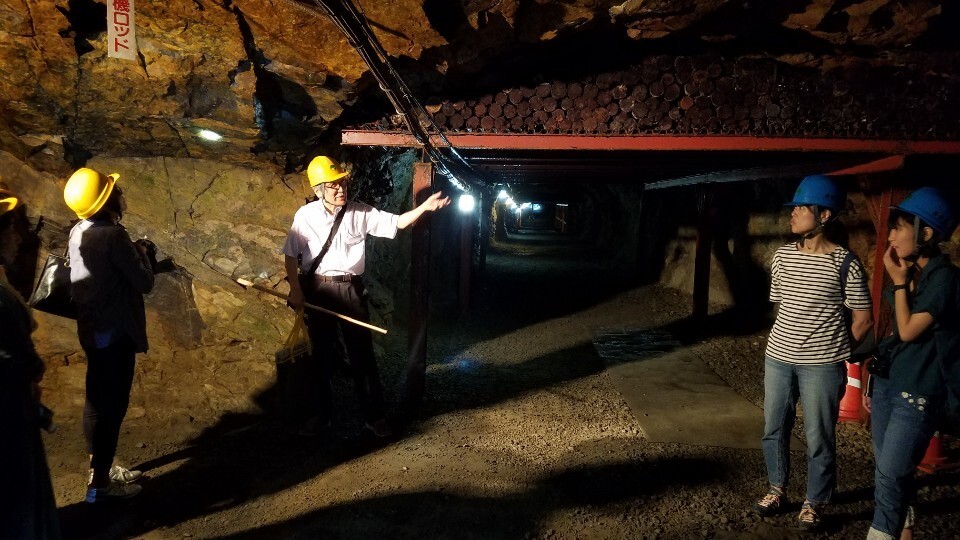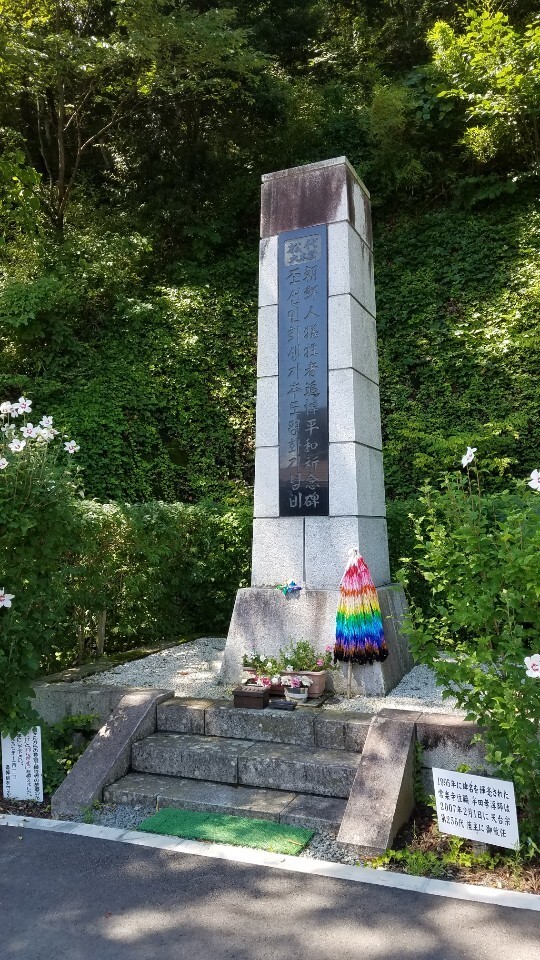hankyoreh
Links to other country sites 다른 나라 사이트 링크
[Reportage] Japan’s secret underground imperial headquarters

On Aug. 10, Akimi Hara, a historical researcher in the city of Nagano, in Japan’s Nagano Prefecture, stood at the section of the Matsushiro Underground Imperial Headquarters under Mount Zozan and pointed to where the tunnel connects with the outside. The beam of light was fixed on the former site of a hanba, or bunkhouse, that housed the Korean slave laborers who had been working on this site during the Japanese colonial occupation.
In November 1944, with defeat looming in World War II, Japan embarked on the construction of an underground bunker in the mountainous area of Matsushiro, about 200km away from Tokyo. The plan was to relocate the Imperial General Headquarters, the body with supreme responsibility for Japan’s war machine, from the Imperial Palace in Tokyo to this underground site in preparation for the Japanese military’s last-ditch defense of the Japanese home islands.
The construction project was assigned to two of Japan’s leading construction companies, Nishimatsu and Kajima. It’s estimated that some 6,000 Koreans and 3,000 Japanese were employed there, but no definite records have survived — the Japanese military destroyed them all after its defeat in the war.
The public is currently allowed to access a 500m stretch of tunnel under Mount Zozan, which was supposed to hold the NHK radio broadcaster and some government offices. Today, the Matsushiro bunker has become a major tourist destination, attracting 50,000 visitors each year.
The project was so secretive that, when construction began, the Japanese military’s work supervisor didn’t even know what was being built. Construction was terminated with Japan’s surrender on Aug. 15, 1945, when nearly three quarters was already complete.
One of the visitors to the Mount Zozan site that Saturday was a 68-year-old woman named Kazuko Hiramatsu. “The only point of the construction was to protect themselves,” the woman said, referring to the war leadership. “It makes me sorry to think that Koreans lost their lives during the construction. We mustn’t let there be another war.”
Another group of Japanese tourists declined to go on the record because of the ongoing dispute between Japan and South Koreans over the issue of forced labor.
The work conditions there were brutal. Right next to the Mount Zozan site is an exhibition hall set up by Japanese citizens from Matsushiro. The hall displays items from the time, including an A-frame carrier used to haul out the rubble produced by dynamite blasts — when filled with rocks, the carrier would have weighed 60-80kg.
“In alternating shifts of 12 hours, the workers managed to dig a total of 13km of tunnels in just nine months. Under normal conditions, that would’ve taken several years,” Hara said.

No precise figure for Korean victims
There are no precise figures about the number of Koreans who died during their work there. Research published in 2011 by a South Korean government committee charged with investigating forced labor during the Japanese colonial occupation only turned up 18 victims, but the actual number is presumed to be between 220 and 650.
Emoji, a Buddhist temple located nearby, contains a stele erected in the honor of a Korean who died there. The name on the stele, Ziro Nakano, is a Japanese one, which the individual had been forced to adopt because of colonial-era naming regulations.
“We don’t know his Korean name. We were asked to handle the remains by an employee from Nishimatsu. Later, we got a letter from [his family in] Korea, explaining that they were poor farmers and couldn’t afford to come to Japan to collect the remains,” said Jikyo Nakanishi, an abbot at the temple.
In 2005, Ziro Nakano’s remains were transferred to the National Mang-Hyang Cemetery, a cemetery for Koreans who died overseas in South Chungcheong Province, and a stele was erected at the temple to record that fact. But this was one of the few cases in which a victims’ remains were sent back home. Even vague personal details are only known for four of the deceased.
Though several hundred people are believed to have died, no one knows what happened to their remains. All that’s left is fragmentary testimony that Japanese civilians employed by the military burned the bodies of deceased Koreans at a crematorium.
Industrial comfort stations
There were also “industrial comfort stations” near the construction site of the Matsushiro bunker. Such comfort stations were set up by Japanese companies all over the country, from Kyushu to Hokkaido, with the purpose of monitoring Korean workers and preventing them from running away. “There were four or five Korean women at these comfort stations,” recalled Nakanishi, the abbot at the Buddhist temple, who had been 12 years old in 1945. There had been enough comfort stations in the area for him to remember them all these years later. The comfort stations, which were presumably visited by high-ranking Korean workers, were torn down in 1991.
The sad history of the Matsushiro bunker has been passed down by ordinary Japanese people who lived in the area. In 1995, a Japanese civil group erected a “monument to peace” at the entrance to the Mount Zozan site, in the memory of the Koreans who died there, and the group also collected related testimony.
But this area has also felt the impact of the “historical revisionism” that has rocked Japan since Shinzo Abe became prime minister. In 2014, the city of Nagano taped over the word “forcibly” in the phrase “locals and Koreans were forcibly mobilized.” Following criticism from civil groups, the city put up a new notice with altered language, which said, “There are various opinions, and some people think that not everyone was forcibly mobilized.”

Japan uses various categories of mobilization to deny instances of forced labor
The forced mobilization of Koreans took place in several ways, including recruitment, government placement, and conscription. The fact that the workers at the Matsushiro bunker represented a mix of these various categories is being exploited in the attempt to deny that there was any forced labor.
Even within the categories of recruitment and government placement, however, it was common for workers to be rounded up in what amounted to kidnapping. After being mobilized, the workers were under the constant surveillance of the company and government officials to ensure they didn’t run away, and a substantial amount of their wages was withheld, on the pretext of being saved on their behalf.
Last year, a list turned up with the names of some 2,600 Koreans who appeared to be the workers who’d been forcibly mobilized for construction at the Matsushiro bunker and their family members. “The list can be viewed upon request at our local exhibition or at the National Diet Library,” Hara said.
“These days, more and more Japanese young people say there wasn’t any forced labor. An increasing number of the visitors to the bunker are members of the online right-wing groups. I encourage them to give some more thought to the violent nature of the state,” he said.
By Cho Ki-weon, Tokyo correspondent
Please direct comments or questions to [english@hani.co.kr]

Editorial・opinion
![[Column] Season 2 of special prosecutor probe may be coming to Korea soon [Column] Season 2 of special prosecutor probe may be coming to Korea soon](https://flexible.img.hani.co.kr/flexible/normal/500/300/imgdb/original/2024/0426/3317141030699447.jpg) [Column] Season 2 of special prosecutor probe may be coming to Korea soon
[Column] Season 2 of special prosecutor probe may be coming to Korea soon![[Column] Park Geun-hye déjà vu in Yoon Suk-yeol [Column] Park Geun-hye déjà vu in Yoon Suk-yeol](https://flexible.img.hani.co.kr/flexible/normal/500/300/imgdb/original/2024/0424/651713945113788.jpg) [Column] Park Geun-hye déjà vu in Yoon Suk-yeol
[Column] Park Geun-hye déjà vu in Yoon Suk-yeol- [Editorial] New weight of N. Korea’s nuclear threats makes dialogue all the more urgent
- [Guest essay] The real reason Korea’s new right wants to dub Rhee a founding father
- [Column] ‘Choson’: Is it time we start referring to N. Korea in its own terms?
- [Editorial] Japan’s rewriting of history with Korea has gone too far
- [Column] The president’s questionable capacity for dialogue
- [Column] Are chaebol firms just pizza pies for families to divvy up as they please?
- [Column] Has Korea, too, crossed the Rubicon on China?
- [Correspondent’s column] In Japan’s alliance with US, echoes of its past alliances with UK
Most viewed articles
- 1[Column] Season 2 of special prosecutor probe may be coming to Korea soon
- 2‘We must say no’: Seoul defense chief on Korean, USFK involvement in hypothetical Taiwan crisis
- 3No good, very bad game for Korea puts it out of Olympics for first time since 1988
- 4Division commander ordered troops to enter raging flood waters before Marine died, survivor says
- 5Is Japan about to snatch control of Line messenger from Korea’s Naver?
- 6Korea’s 1.3% growth in Q1 signals ‘textbook’ return to growth, says government
- 7Is N. Korea threatening to test nukes in response to possible new US-led sanctions body?
- 8[Editorial] Korea’s surprise Q1 growth requires objective assessment, not blind fanfare
- 9[Editorial] New weight of N. Korea’s nuclear threats makes dialogue all the more urgent
- 10‘Weddingflation’ breaks the bank for Korean couples-to-be